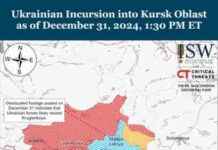Russian forces unleashed a formidable overnight air assault on various Ukrainian regions, deploying nearly 150 long-range attack drones and launching two ballistic missiles. This offensive resulted in civilian casualties and infrastructure damage, with Mykolaiv bearing the brunt of the attack and Odesa Oblast being targeted by ballistic missiles.
Mykolaiv Tragedy
In the wake of the assault, Vitaliy Kim, the head of the Mykolaiv Oblast Military Administration (OMA), revealed that nine Shahed drones were successfully intercepted, but several others managed to evade defenses, causing harm and destruction. Among the casualties was a 64-year-old man who sustained injuries, while significant damage was inflicted on critical infrastructure, including five apartment buildings, shops, and offices. The incident sparked fires that necessitated immediate emergency response efforts.
As the clock struck 12:34 a.m., air raid sirens blared across Mykolaiv Oblast, signaling impending danger. Explosions rang out until 2:00 a.m., prompting residents to seek shelter until the all-clear was given, as reported by Suspilne. In the aftermath, the cityscape was marred by the remnants of destruction, with buildings bearing the scars of the violent assault.
Mayor Oleksandr Sienkevych of Mykolaiv reassured residents that municipal teams had rallied to clear debris and provide aid to those affected by the tragedy. The resilience of the community shone through as they banded together to navigate the aftermath of the devastating attack.
Part of a Larger Offensive
The aerial onslaught orchestrated by Russian forces involved the deployment of 143 drones, including Shahed long-range attack drones and decoy UAVs. These drones were launched from strategic sites in Russia, including Oryol, Bryansk, and Shatalovo, before infiltrating Ukrainian airspace.
Ukraine’s Air Force reported that a significant number of the drones were successfully neutralized by air defense systems, with 95 drones being shot down and 46 others losing radar contact and presumably crashing safely. However, the report indicated that at least two drones may have penetrated defenses and reached their intended targets.
The response from Ukraine’s air defense units was swift and coordinated, involving aviation teams, surface-to-air missile systems, electronic warfare specialists, and mobile fire groups. The impact of the assault reverberated across four regions—Kyiv, Sumy, Mykolaiv, and Odesa oblasts—leaving a trail of destruction in its wake.
By 9:00 a.m., the Ukraine Air Force confirmed the interception of Shahed drones over various regions, including Kharkiv, Poltava, Sumy, Chernihiv, Cherkasy, Kyiv, Zhytomyr, Khmelnytskyi, Dnipropetrovsk, and Mykolaiv Oblasts. Additionally, two ballistic missiles were launched from Russian-occupied Crimea towards Odesa Oblast, as per reports from Ukraine’s Southern Air Command.
The tense situation in Odesa Oblast was marked by air raid alerts that spanned from 4:29 a.m. to 4:55 a.m., as monitoring channels detected incoming missiles aimed at Odesa’s Zatoka. Despite the heightened state of alert, details regarding casualties or structural damage remained unconfirmed at the time.
With the relentless onslaught showing no signs of abating, the Ukrainian populace braced themselves for further acts of aggression, underscoring the urgent need for international intervention to quell the escalating conflict. The harrowing reality of war had once again descended upon the region, leaving a trail of devastation and uncertainty in its wake.

















